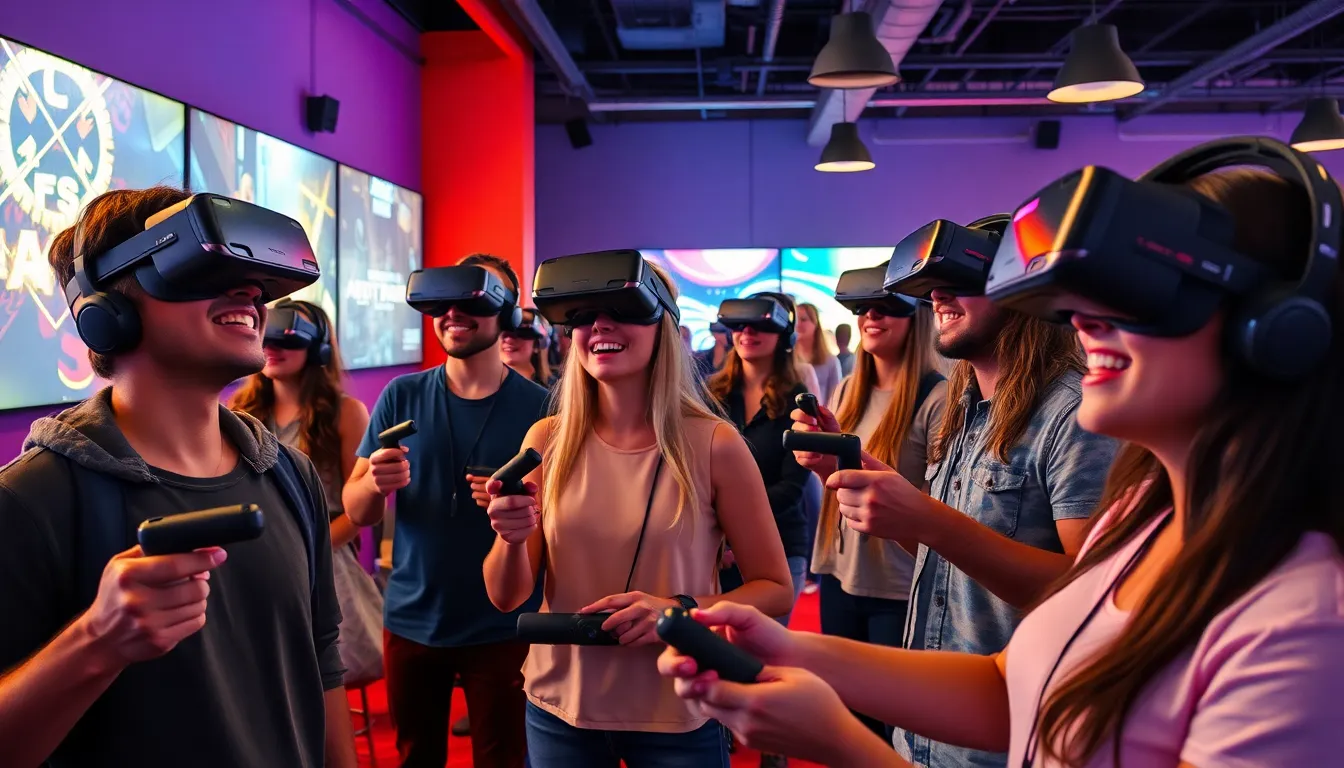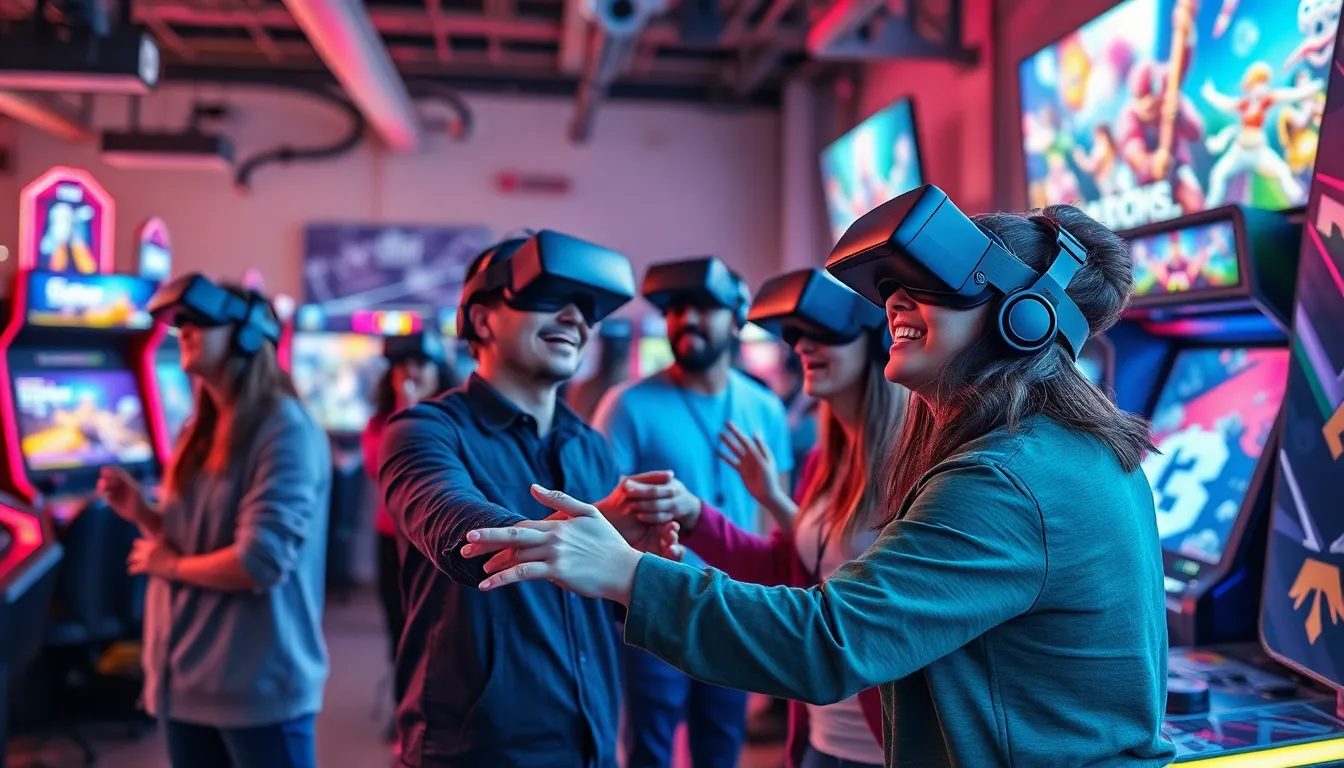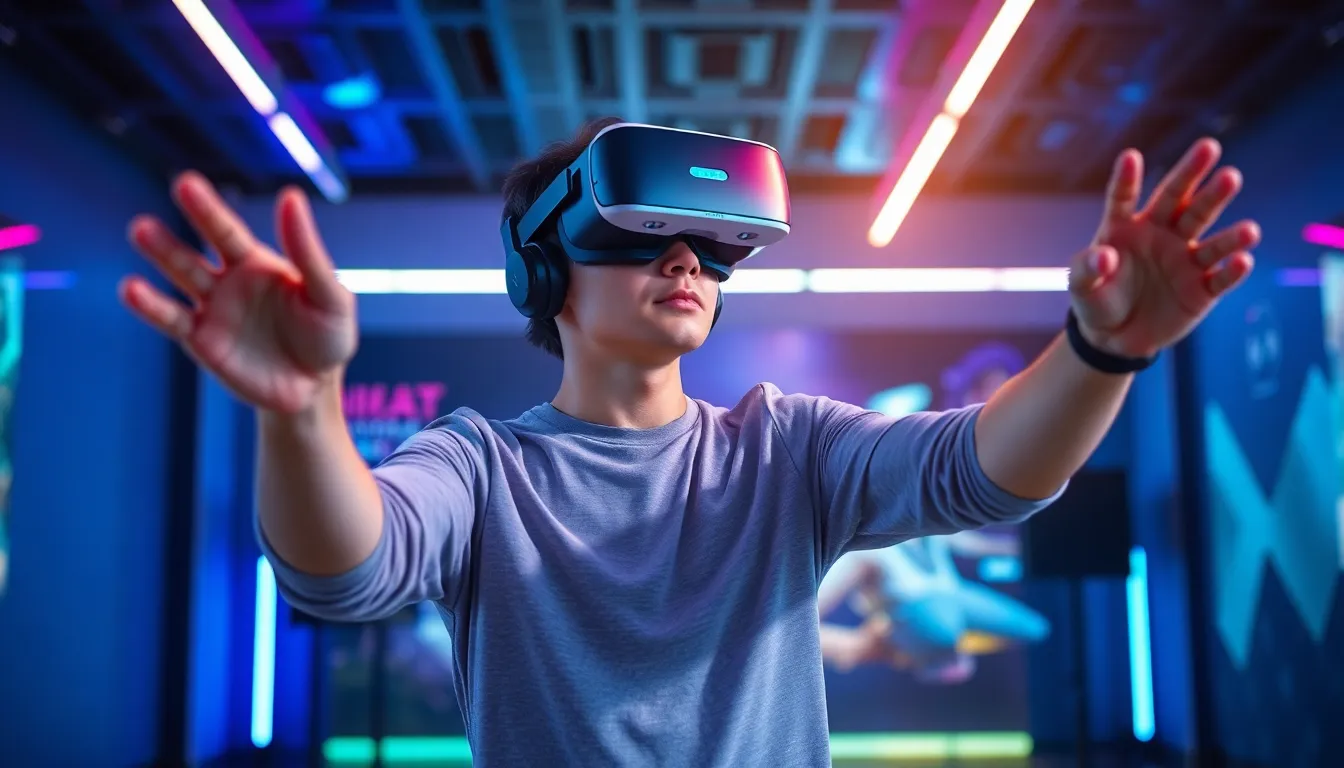Virtual reality arcade games are transforming the way players experience gaming. These immersive environments transport users into fantastical worlds where they can interact in ways traditional games can’t match. With cutting-edge technology, VR arcades offer a unique blend of entertainment and social interaction, drawing in both seasoned gamers and newcomers alike.
As the popularity of VR continues to soar, arcades are evolving to meet the demand for thrilling and innovative experiences. Players can step into a variety of genres, from action-packed shooters to mind-bending puzzles, all while enjoying the camaraderie of friends or fellow enthusiasts. This shift not only revitalizes the arcade scene but also showcases the limitless potential of virtual reality in the gaming industry.
Table of Contents
ToggleOverview of VR Arcade Games
VR arcade games offer an immersive gaming experience that engages players in ways traditional games don’t. These games transport users into virtual worlds, enabling unique interactions and challenges. Players can explore environments, solve puzzles, or compete in high-stakes scenarios.
Advancements in technology enhance the VR arcade experience. High-resolution displays, motion tracking systems, and advanced sound design create a realistic atmosphere. Players benefit from these innovations as they interact with 3D environments and avatars.
Various genres populate the VR arcade landscape, including racing, shooting, and horror games. Each genre caters to different interests, providing a broad selection for diverse audiences. For example, racing games let players drive high-speed vehicles, while horror games induce adrenaline-pumping experiences through immersive storytelling.
Social interaction represents a key component of VR arcades. Players often compete or collaborate with friends, strengthening bonds through shared experiences. Multi-player setups enable teams to strategize during challenges, enhancing the overall enjoyment.
As VR technology evolves, so do the possibilities for arcade gaming. New game titles continually emerge, each offering innovative mechanics and engaging narratives. This growth contributes to the expansion of VR arcades as popular entertainment venues, emphasizing their role in the broader gaming landscape.
Popular VR Arcade Games

VR arcade games attract players with their immersive gameplay and captivating experiences. Here are some popular titles that showcase the diversity and excitement of the VR gaming environment.
Game 1: Beat Saber and Features
Beat Saber combines rhythm with swordplay. Players slash through blocks representing musical beats. Features include:
- Gameplay Mechanics: Uses motion controllers to slice blocks in time with music.
- Song Library: Offers a vast selection of songs across various genres.
- Multiplayer Mode: Allows players to compete for high scores, promoting friendly competition.
Game 2: Job Simulator and Features
Job Simulator provides a humorous take on work life in a futuristic setting. Players take on various jobs in a world where robots perform all tasks. Features include:
- Interactive Environment: Engages players with a fully interactive workspace for each job type.
- Variety of Jobs: Includes roles like chef, office worker, and car mechanic.
- Humorous Challenges: Offers quirky tasks that add fun elements to traditional job duties.
Game 3: Arizona Sunshine and Features
- Co-op Mode: Enables players to team up with friends for cooperative gameplay.
- Dynamic Environments: Engages players with realistic landscapes and diverse settings.
- Combat Mechanics: Provides a range of weapons for players to fend off zombies, enhancing the thrill of survival.
Benefits of VR Arcade Games
VR arcade games offer numerous benefits that enhance the gaming experience.
- Immersive Experience
VR arcade games provide an unparalleled immersive experience, allowing players to feel as if they’re truly part of the game world. Players interact with 3D environments, enhancing engagement and enjoyment.
- Social Interaction
VR arcade settings facilitate social interaction, enabling players to compete or cooperate with friends. These shared experiences foster camaraderie and enjoyment, making gaming a social activity.
- Physical Activity
Many VR arcade games require players to move and engage physically. This promotes physical activity and provides a break from sedentary screen time, benefiting overall health.
- Diverse Game Selection
VR arcades offer a wide array of genres, catering to various interests. From racing simulations to horror adventures, players can choose games that match their preferences, increasing satisfaction.
- Skill Development
Players enhance various skills while engaging in VR arcade games. Quick reflexes, problem-solving abilities, and hand-eye coordination improve, providing mental and physical benefits.
- Technological Innovation
VR arcades utilize cutting-edge technology for gaming. High-resolution graphics and advanced motion tracking systems create realistic experiences, attracting tech enthusiasts.
- Accessible Gaming
VR arcade games provide an accessible entry point for players who may not own VR equipment. Players can experience the technology without investment, expanding the gaming audience.
- Engaging Narratives
Many VR arcade games include captivating narratives that draw players in. Intriguing storylines enhance engagement and encourage repeat visits to arcade venues.
The benefits of VR arcade games make them an attractive option for both casual and avid gamers, contributing to their popularity in the entertainment landscape.
Challenges Faced by VR Arcade Games
VR arcade games encounter several challenges that impact their growth and player experience.
High Equipment Costs
High-quality VR systems present significant costs for arcade operators. Initial investments in headsets, motion tracking technology, and gaming rigs can exceed thousands of dollars. Continuous upgrades are necessary, which adds to ongoing expenses.
Space Limitations
Space requirements for VR gaming setups can hinder arcade operation. Dedicated areas are essential to accommodate equipment and player movement. Smaller venues may struggle to provide adequate space for immersive experiences, limiting gameplay options and player capacity.
Technical Issues
Technical difficulties arise during gameplay, affecting user experience. Malfunctions in tracking systems or discomfort caused by hardware can disrupt sessions. Ensuring reliable performance requires frequent maintenance and technical expertise.
Limited Game Selection
Game availability remains a hurdle due to licensing restrictions and development costs. Many popular VR titles focus on solo play, reducing social interaction opportunities in multiplayer settings. A limited lineup can deter repeat visits from gamers seeking variety.
User Adaptation
User adaptation to VR experiences varies widely. Some players may experience motion sickness or disorientation, impacting overall enjoyment. Providing support and guidance for newcomers is crucial to enhance their comfort levels.
Competition from Other Entertainment Venues
Competition from other gaming and entertainment options represents a challenge. Traditional arcades, gaming consoles, and outdoor activities vie for consumer attention. Establishing unique offerings and promotional strategies helps VR arcades distinguish themselves in the market.
Market Awareness
Market awareness of VR arcade experiences remains limited. Many potential players are unfamiliar with available games and technology. Implementing marketing strategies that highlight the benefits and excitement of VR gaming can attract a broader audience.
Adapting to these challenges allows VR arcade games to thrive and expand their reach, enhancing the overall gaming experience for players.
Future Trends in VR Arcade Games
Emerging trends in VR arcade games indicate a shift towards enhanced experiences and expanded accessibility. Integration of artificial intelligence (AI) enables customized gaming experiences, as AI adjusts game difficulty based on player performance. Enhanced graphics technologies, like ray tracing, create realistic lighting and textures, further immersing players in virtual environments.
Increased multiplayer functionalities are likely to gain traction. Online connectivity allows players to compete or collaborate with friends and strangers globally, enhancing the social aspect of VR gaming. Social VR environments, where users can interact beyond gameplay, will likely become more prevalent, fostering community engagement.
Development of location-based experiences stands out as another trend. These experiences blend virtual elements with real-world locations, creating unique gameplay opportunities. For instance, VR arcades may expand to include outdoor experiences, where players navigate through themed areas using VR technology.
Affordability of VR equipment is set to improve, leading to larger numbers of VR arcade establishments. As costs decrease, more entrepreneurs may enter the market, representing a chance for innovation. Furthermore, advancements in mobile VR technology can bring arcade experiences to home settings, offering players convenience and flexibility.
Popularity of subscription models is on the rise. These models provide access to a wide variety of games for a monthly fee, attracting players interested in broad experiences without the commitment to individual game purchases. This approach may increase player retention and loyalty over time.
Focus on health and wellness within VR games may become significant. Titles promoting physical activity or mindfulness through interactive experiences can cater to growing health-conscious demographics. Such games encourage movement and relaxation, broadening the appeal of VR arcades.
Sustainability initiatives are likely to gain importance in the arcade industry. Operators may adopt eco-friendly practices, from using energy-efficient hardware to recycling gaming equipment. This focus can resonate with environmentally-conscious customers, enhancing brand loyalty.
Overall, future trends in VR arcade games reflect a commitment to innovation, accessibility, and community engagement, paving the way for a dynamic gaming landscape.
VR arcade games are reshaping the entertainment landscape by offering immersive experiences that traditional gaming simply can’t match. As technology continues to advance, players can expect even more engaging narratives and innovative gameplay mechanics. The social aspect of VR arcades fosters connections among friends and family, making each visit a memorable outing.
With a growing variety of genres and the potential for enhanced accessibility, VR arcades are poised to attract a wider audience. As the industry embraces trends like AI integration and sustainability, the future looks bright for both gamers and arcade owners alike. The evolution of VR gaming is not just a trend; it’s a revolution that promises to redefine how people engage with games and each other.








